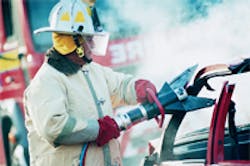It’s a question on many people’s minds: “How long will the hoses last on our system?”
There’s not a week that goes by that someone doesn’t ask this question. The answer is always the same. It depends on the system and you. Per SAE specifications, the shelf life of bulk rubber hose is 40 quarters (10 years) from the date of manufacture, and it is considered unlimited for thermoplastic hose. In both cases, the specification states it is in controlled conditions. The hose must be stored in a subdued light and a controlled temperature with no fittings attached. This is fine if you are storing hose in inventory for future use, but what can you expect after the fittings are attached and the hose is installed on a 14 million dollar hydraulic press that operates 24/7?
Put a STAMP on it
So many variables come into play that it is nearly impossible to accurately determine the service life of a hose assembly. But an assessment starts by being fully aware of all the operating parameters. The best way to approach this is to use the acronym STAMP (Size, Temperature, Application, Media, and Pressure) and consider all these factors when determining hose life.
Size — What are the sizes of components and the lines used to operate them? How long are the hose assemblies? Are any too long or too short? SAE 100R2 specification allows hose to change in length 2 to 4% when it is pressurized. This can be a considerable change depending on the overall length of the assembly and how it is installed. If it’s in a vertical position, this will put more tension and stress on the hose’s construction.
Temperature — How hot or cold is the hydraulic fluid and the external environment? Is the temperature controlled?
Application — What does the hydraulic system do, how and where does it operate, and for how long does it operate? What is its duty cycle? Is the equipment being used outside? Is it exposed to ozone or direct sunlight?
Media — What fluid is used and who is the manufacturer? Hydraulic fluids today can have so many different additives that it may be impossible to lump them all into one category. Be sure to keep the manufacturer’s material safety data sheet handy. Is the fluid clean? What is the condition of the components being used to ensure the fluid is clean and within the temperature requirements?
Pressure — What is the system’s operating pressure? Do pressure spikes occur? The adverse effects of a flow surge or spike on the cons t ruct ion of hos e can be extreme even if it only lasts a millisecond. Is there a lot of impulsing in the hoses causing them to expand and contract?
Schedule regular maintenance
Even if you know all the operating parameters of a system, it is difficult to give an exact answer to what is the expected service life of a hose. The importance of incorporating an adequate maintenance program cannot be overemphasized. Ideally, a maintenance program should exist not just for the hose, but for the entire hydraulic system as well.
This brings up another question that does not have just one answer. How often and to what extent should you inspect and replace hoses? The best way to determine a reliable schedule for inspection and replacement intervals is based on the actual history of the equipment. Most shops keep records of when a machine was shut down due to a failed hose or other component failure. If you haven’t kept these records, begin to do so for future reference. You should also consider what the government and industry recommendations are for the equipment. In some cases, industry standards advise when to replace certain components — especially if a failure could result in personal injury or death.
What’s it worth?
Keep in mind the associated costs and repercussions to your business if you experience failures or down time. You must be the judge. Is it better to replace a $100 hose assembly twice a year or spend thousands to clean up a spill or to make repairs from a burst in a line that could have been avoided?
Some of the systems I’ve worked on haven’t needed a complete overhaul inspection every time. Depending on the purpose of the equipment, a complete visual inspection once a month may be adequate. Follow this up with a complete overhaul and replacement of hoses once a year or every other year, depending on how critical the function of the equipment is. Remember that a component that fails in service is usually more costly than replacing or rebuilding that component during a planned maintenance procedure. When a hose assembly or other component fails in service, quite often it will affect the rest of the system. Consequently, parts that otherwise would have been serviceable may also have to be replaced.
Operating a hydraulic system without incorporating an effective maintenance program can be costly by reducing the service life of hose assemblies as well as most of the other components in the system. When determining the frequency and depth of a maintenance program, keep in mind what the equipment is being used for. Is this equipment operating a nuclear submarine, where failure could have fatal ramifications? Or is it producing a minor part for some product that is not life threatening? Answering this question should give you a good start as to how often to schedule an inspection.
Obviously, we cannot know every operating parameter of a system. Therefore, implementing a regular preventive maintenance program for the replacement of hoses will result in prolonging the life and increasing the efficiency of that equipment.
For more information, contact Ron Mramor, Mobile Systems- Fluid Connector Specialist, at [email protected] or call (440) 666-4162.
About the Author
Ron Mramor
Parker Hannifin Corp.

Leaders relevant to this article:


